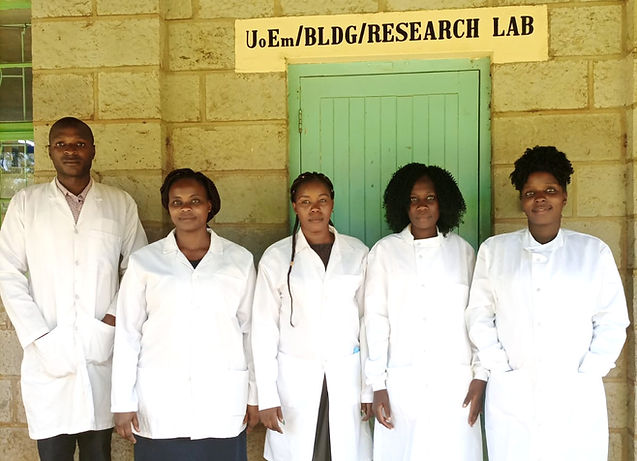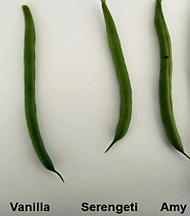Marker-assisted genetic improvement of French bean and dry bean varieties for resistance to multiple diseases in Kenya

University of Embu, Embu, Kenya

The Embu University team. Left to right: Mr Brian Wafula, Dr Esther Arunga, Ms Serah Njau, Ms Nancy Munubi and Ms Grace Wambui Watare.
PROJECT OVERVIEW
Background
French bean (or green bean) is one of the most valuable export commodities produced in Kenya; the crop is sold both as fresh produce or in canned form. Its cultivation represents a major source of income for small-holder farmers. Several pathogens compromise the crop’s productivity: the viruses bean common mosaic virus (BCMV) and bean common mosaic necrosis virus (BCMNV); and the fungi Pseudocercospora griseola (responsible for angular leaf spot; ALS), Uromyces appendiculatus (rust) and Colletotrichum lindemuthianum (anthracnose; ANT). Chemical control of these diseases is not economically viable for small-scale farmers, while it also presents a hazard to both human health and the environment.
Additionally, two dry bean cultivars (Nyota and Kat/Bean 1) will be improved for resistance to multiple diseases. Two varieties will serve as donor parents: EMBEAN14, locally known as “Mwende”, is a determinate variety tolerant to Angular Leaf Spot (ALS), root rots, rust, and anthracnose (ANT); and MCM 2001, a CIAT-developed variety that carries genes for resistance to Bean Common Mosaic Virus (BCMV) and Bean Common Mosaic Necrosis Virus (BCMNV).
_edited.jpg)
Field trials in Mwea, Kenya, 2025.
Objectives
-
To evaluate the yield performance of advanced French bean breeding lines in multiple locations and seasons in Kenya.
-
To characterise the bean rust resistance genes and develop molecular markers linked to rust resistance genes in MU#13 French bean breeding line.
-
To breed disease resistance in market-preferred dry bean varieties through introgression of multiple disease resistances.
Progress to date
-
The project continues to evaluate French bean breeding lines that combine resistance to bean rust, anthracnose (ANT), Angular Leaf Spot (ALS), Bean Common Mosaic Virus (BCMV), and Bean Common Mosaic Necrosis Virus (BCMNV). Several lines have been found to possess different combinations of resistance genes, as well as varying degrees of resistance to the respective diseases. Two populations have been developed: 1) UoEm#6, derived from parallel backcrosses involving the following parents: Amy (recurrent), Mexico 54 (ALS-resistant), G2333 (ANT-resistant), and MU#13 (rust-resistant), was used as the donor to improve three market class cultivars: Vanilla, Serengeti, and Source. Data analysis is currently ongoing. 2) a population of BC₂F₄ French bean breeding lines that combine resistance to bean rust, ANT, ALS, BCMV, and BCMNV (bc-3), with Vanilla as the recurrent parent. Evaluation of these lines is in progress.
-
In addition, two dry bean cultivars, Nyota and Kat/Bean 1, were crossed with EMBEAN14 (resistant to ANT and ALS), MCM 2001 (resistant to BCMV/BCMNV), MCM 5001, and MCM 1015 (both resistant to BCMNV). Nyota and Kat/Bean 1 have also been crossed with French bean donors carrying the target resistance traits. F₂ populations are currently being developed.

i

ii
G2333 Mex 54

iii

iv
Some of the French beans selected for improvement (i); dry bean donor varieties for disease resistance (G2333 for anthracnose and Mex 54 for angular leaf spot; ii); the Embu team doing field evaluations (iii); advanced French bean breeding lines (iv).
PROJECT TEAM MEMBERS

Dr Esther Arunga
Principal Investigator, University of Embu.
Senior Lecturer at the Agricultural Resource Management, Dr Arunga, has led the KT French bean breeding project at Embu University College, Kenya, since 2013. A Kirkhouse Trust MSc and PhD scholar, she completed her doctoral degree in 2012. The title of her thesis was ‘French bean breeding for rust resistance in Kenya: pathogen diversity and host resistance’.

Ms Nancy Munubi
MSc student

Mr Nixon Odiwuor
MSc student
STUDENT PROJECTS
Pyramiding of genes to confer multiple disease resistance into market class French bean varieties in Kenya
Ms Nancy Munubi
MSc in Plant Breeding and Biotechnology, University of Embu.
Supervisors: Dr Esther Arunga and Dr Felix Rotich, University of Embu.
Project objectives
1.To develop French bean breeding lines that combine resistance to multiple diseases through the stacking of disease resistance genes.
2.To evaluate the yield traits of French bean lines with pyramided genes for disease resistance.
3.To characterise the anthracnose resistance genes in the MU#13 French bean breeding line.

Ms Nancy Munubi
Progress to date
-
BC2F4 lines from the main programme were selected using molecular markers for resistance to ANT, ALS and BCMV/BCMNV. These were evaluated for resistance in the field and yield traits. 12 lines showed resistance to the three pathogens with others showing variable responses
-
The characterisation of the anthracnose resistance gene in MU#13 is ongoing.

i

ii

iii
Development of the F1 population (i); successful crosses (ii and iii).
Prevalence and host resistance of French beans to common bean rust in Western and Central Kenya
Mr Nixor Odiwour
MSc in Plant Breeding and Biotechnology, University of Embu.
Supervisors: Dr Esther Arunga, University of Embu.
Project objectives
-
To evaluate advanced French bean breeding lines for resistance to multiple diseases under field and greenhouse conditions.
-
To determine the resistance genes in advanced breeding lines using molecular markers
-
To evaluate the agronomic performance and yield stability of advanced breeding lines in multiple locations

Mr Nixor Odiwuor
PUBLICATIONS
-
Njau, S. N., Parker, T. A., Duitama, J., Gepts, P., & Arunga, E. E. (2024). QTL mapping for pod quality and yield traits in snap bean (Phaseolus vulgaris L.). Frontiers in Plant Science, 15, 1422957.
-
Masheti, Y., Muthomi, J. W., Muiru, W. M., Arunga, E. E., & Gepts, P. (2024). Inoculum sources and management of bean scab caused by Elsinoë phaseoli. Journal of Phytopathology, 172(4), e13355.
-
Misango, S., Otsyula, R., & Arunga, E. E. (2023). Resistance to Pythium root rot and anthracnose among Kenyan common bean genotypes and marker-assisted introgression of resistance genes. Journal of Crop Improvement, 37(6), 853-873.
-
Wafula, B.W., Arunga, E.E., & Rotich, F. 2023. Prevalence and Host Resistance to Common Bean Rust Disease in Western and Central Kenya. International Journal of Agronomy. Doi https://doi.org/10.1155/2023/6064130.
-
Watare, G.W., Gichimu, B.M. & Arunga, E.E. 2023. Host Plant Resistance to Bean Common Mosaic Necrosis Virus among Snap Bean Cultivars in Kenya. Journal of Plant Protection Research, 63: 2.
-
Parker, T.A., Cetz, J., de Sousa, L.L., Kuzay, S., Lo, S., de Oliveira Floriani, T., Njau, S., Arunga, E., Duitama, J., Jernstedt, J. and Myers, J.R., 2022. Loss of pod strings in common bean is associated with gene duplication, retrotransposon insertion, and overexpression of PvIND. New Phytologist 235: 2454-2465.
-
Kamiri, A.K., Arunga, E.E., Rotich, F. and Otsyula, R., 2021. Response of French bean genotypes to Colletotrichum lindemuthianum and evaluation of their resistance using SCAR markers. African Journal of Biotechnology 20: 51-65.
-
Arunga, E.E. and Odikara, O.S., 2020. Characterization of Kenyan French Bean genotypes into gene pool affiliations using allele specific markers. African Journal of Biotechnology 19: 653-660.
-
Kimno, S.K., Kiplagat, O.K., Arunga, E.E. and Chepkoech, E., 2016. Evaluation of selected French bean (Phaseolus vulgaris L.) genotypes for resistance to angular leaf spot (Pseudocercospora griseola) in Western Kenya. Journal of Experimental Agriculture International 13: 1-6.
-
Arunga, E.E., Ochuodho, J.O., Kinyua, M.G., Owuoche, J.O. and Chepkoech, E. 2015. Genetic diversity of determinate French beans grown in Kenya based on morpho-agronomic and simple sequence repeat variation. Journal of Plant Breeding and Crop Science. 7 :240-250.
-
Arunga, E.E., Ochuodho, J.O., Kinyua, M.G. and Owuoche, J.O., 2012. Characterization of Uromyces appendiculatus isolates collected from snap bean growing areas in Kenya. African Journal of Agricultural Research 7: 5685-5691.
-
Arunga E.E., Ochuodho J.O., Kinyua M.G., Owuoche J.O. 2012. Characterization of Uromyces appendiculatus isolates collected from snap bean growing areas in Kenya. African Journal of Agricultural Research 7: 5685-5691 doi: 10.5897/AJAR12.1826.
-
Arunga, E.E., Van Rheenen, H.A. and Owuoche, J.O., 2010. Diallel analysis of Snap bean (Phaseolus vulgaris L.) varieties for important traits. African Journal of Agricultural Research, 5: 1951-1957.
PROJECT LOCATIONS
Location of the University of Embu's field trial sites.


